Environmental management and planning for tourism
VerifiedAdded on 2023/05/30
|17
|4018
|238
AI Summary
This academic report is about the environmental impact which would occur during construction and ongoing operation of a proposed 5-star hotel near the shore of Lake Rotorua. The report considers the relevant plans and legislation implemented in this process including the Distinct Plan and Resources Management Act 1991. The report also states the compliance with six additional criteria and indicators for their monitoring.
Contribute Materials
Your contribution can guide someone’s learning journey. Share your
documents today.
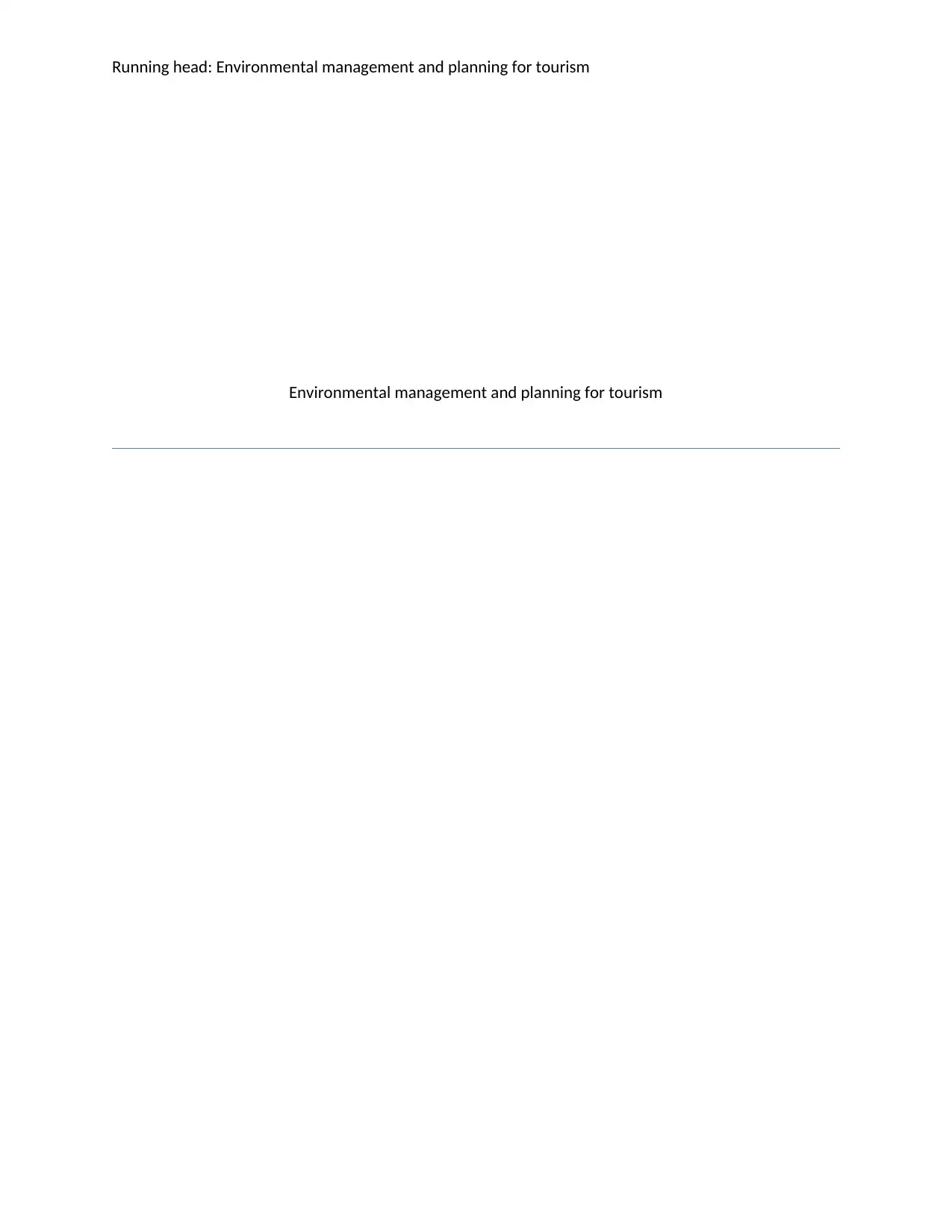
Running head: Environmental management and planning for tourism
Environmental management and planning for tourism
Environmental management and planning for tourism
Secure Best Marks with AI Grader
Need help grading? Try our AI Grader for instant feedback on your assignments.
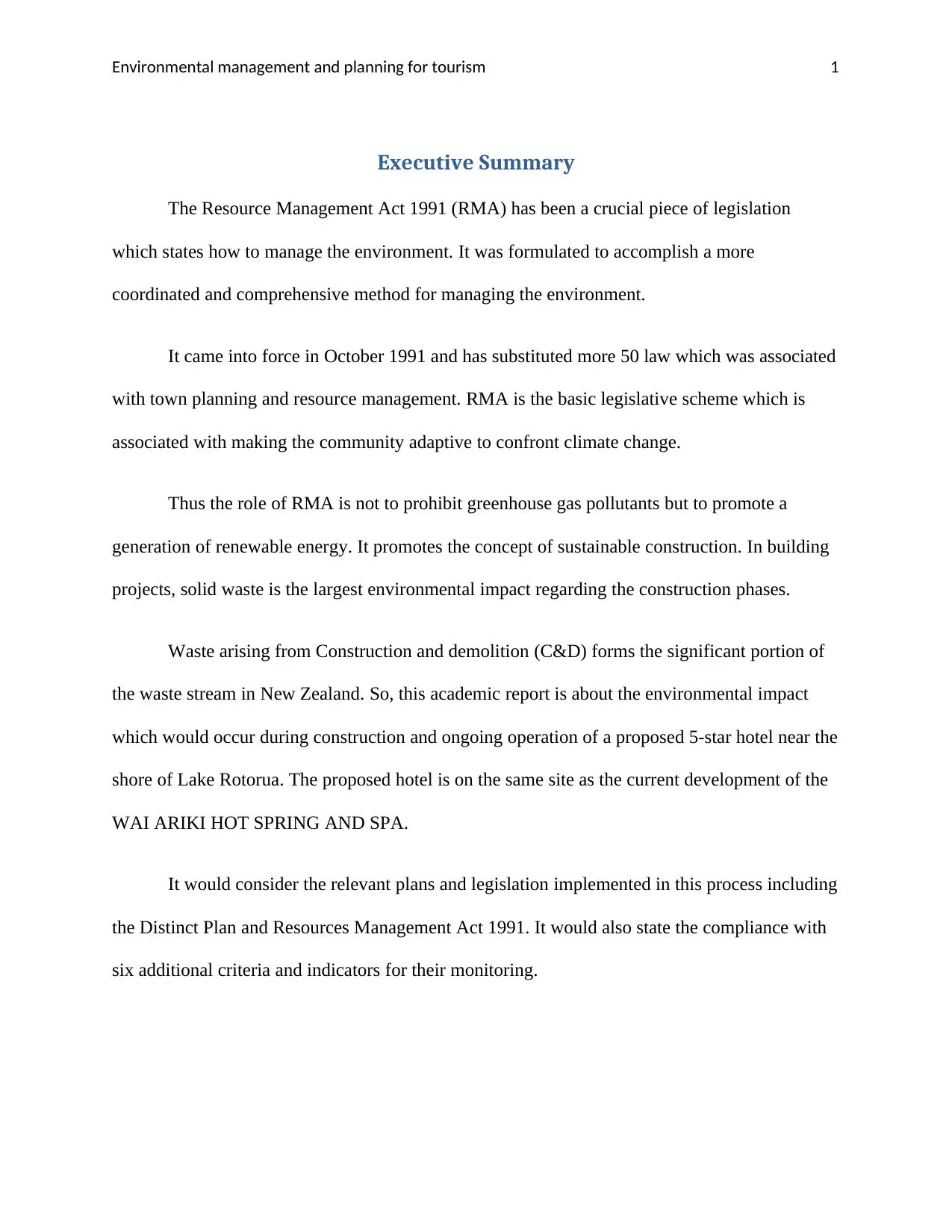
Environmental management and planning for tourism 1
Executive Summary
The Resource Management Act 1991 (RMA) has been a crucial piece of legislation
which states how to manage the environment. It was formulated to accomplish a more
coordinated and comprehensive method for managing the environment.
It came into force in October 1991 and has substituted more 50 law which was associated
with town planning and resource management. RMA is the basic legislative scheme which is
associated with making the community adaptive to confront climate change.
Thus the role of RMA is not to prohibit greenhouse gas pollutants but to promote a
generation of renewable energy. It promotes the concept of sustainable construction. In building
projects, solid waste is the largest environmental impact regarding the construction phases.
Waste arising from Construction and demolition (C&D) forms the significant portion of
the waste stream in New Zealand. So, this academic report is about the environmental impact
which would occur during construction and ongoing operation of a proposed 5-star hotel near the
shore of Lake Rotorua. The proposed hotel is on the same site as the current development of the
WAI ARIKI HOT SPRING AND SPA.
It would consider the relevant plans and legislation implemented in this process including
the Distinct Plan and Resources Management Act 1991. It would also state the compliance with
six additional criteria and indicators for their monitoring.
Executive Summary
The Resource Management Act 1991 (RMA) has been a crucial piece of legislation
which states how to manage the environment. It was formulated to accomplish a more
coordinated and comprehensive method for managing the environment.
It came into force in October 1991 and has substituted more 50 law which was associated
with town planning and resource management. RMA is the basic legislative scheme which is
associated with making the community adaptive to confront climate change.
Thus the role of RMA is not to prohibit greenhouse gas pollutants but to promote a
generation of renewable energy. It promotes the concept of sustainable construction. In building
projects, solid waste is the largest environmental impact regarding the construction phases.
Waste arising from Construction and demolition (C&D) forms the significant portion of
the waste stream in New Zealand. So, this academic report is about the environmental impact
which would occur during construction and ongoing operation of a proposed 5-star hotel near the
shore of Lake Rotorua. The proposed hotel is on the same site as the current development of the
WAI ARIKI HOT SPRING AND SPA.
It would consider the relevant plans and legislation implemented in this process including
the Distinct Plan and Resources Management Act 1991. It would also state the compliance with
six additional criteria and indicators for their monitoring.
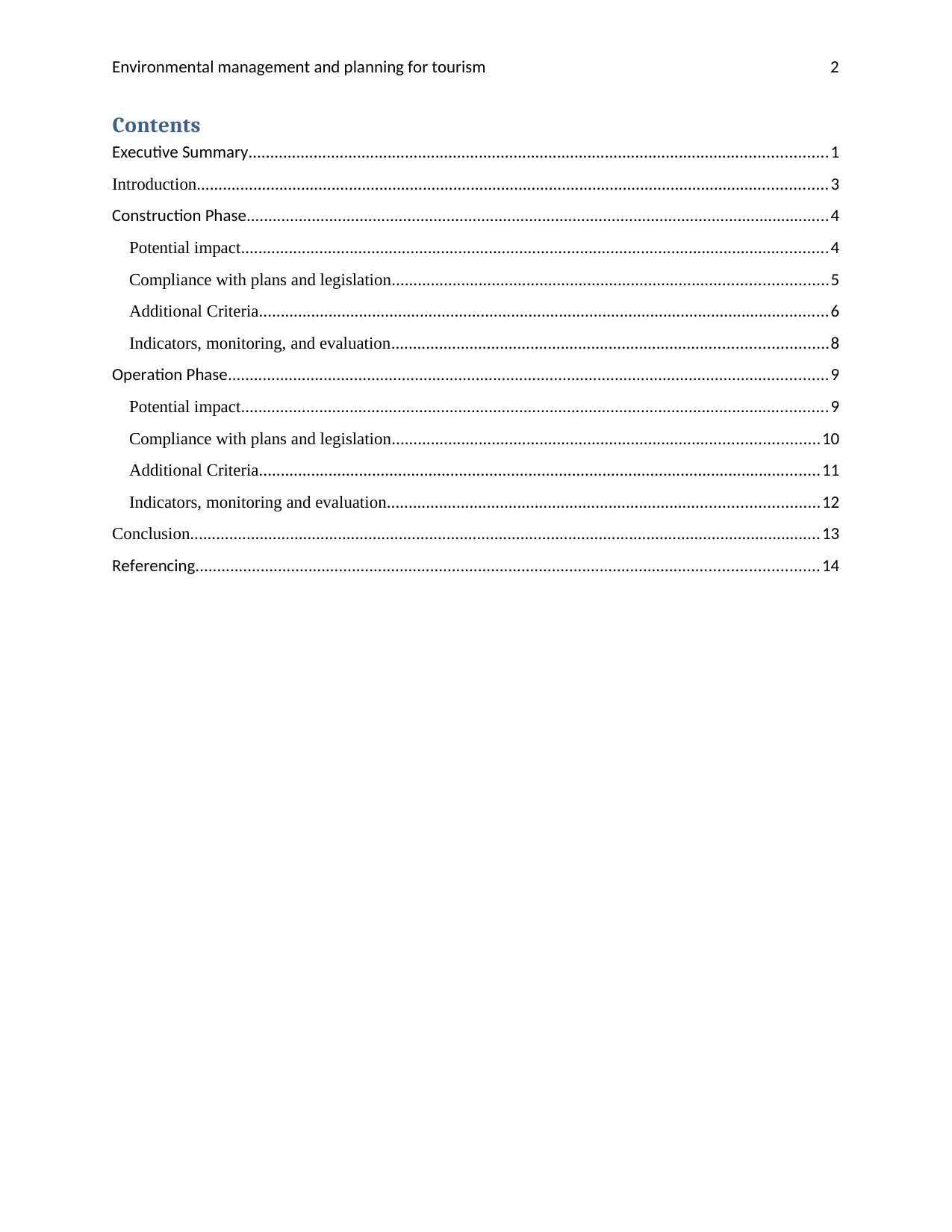
Environmental management and planning for tourism 2
Contents
Executive Summary.....................................................................................................................................1
Introduction.................................................................................................................................................3
Construction Phase......................................................................................................................................4
Potential impact.......................................................................................................................................4
Compliance with plans and legislation....................................................................................................5
Additional Criteria...................................................................................................................................6
Indicators, monitoring, and evaluation....................................................................................................8
Operation Phase..........................................................................................................................................9
Potential impact.......................................................................................................................................9
Compliance with plans and legislation..................................................................................................10
Additional Criteria.................................................................................................................................11
Indicators, monitoring and evaluation...................................................................................................12
Conclusion.................................................................................................................................................13
Referencing...............................................................................................................................................14
Contents
Executive Summary.....................................................................................................................................1
Introduction.................................................................................................................................................3
Construction Phase......................................................................................................................................4
Potential impact.......................................................................................................................................4
Compliance with plans and legislation....................................................................................................5
Additional Criteria...................................................................................................................................6
Indicators, monitoring, and evaluation....................................................................................................8
Operation Phase..........................................................................................................................................9
Potential impact.......................................................................................................................................9
Compliance with plans and legislation..................................................................................................10
Additional Criteria.................................................................................................................................11
Indicators, monitoring and evaluation...................................................................................................12
Conclusion.................................................................................................................................................13
Referencing...............................................................................................................................................14
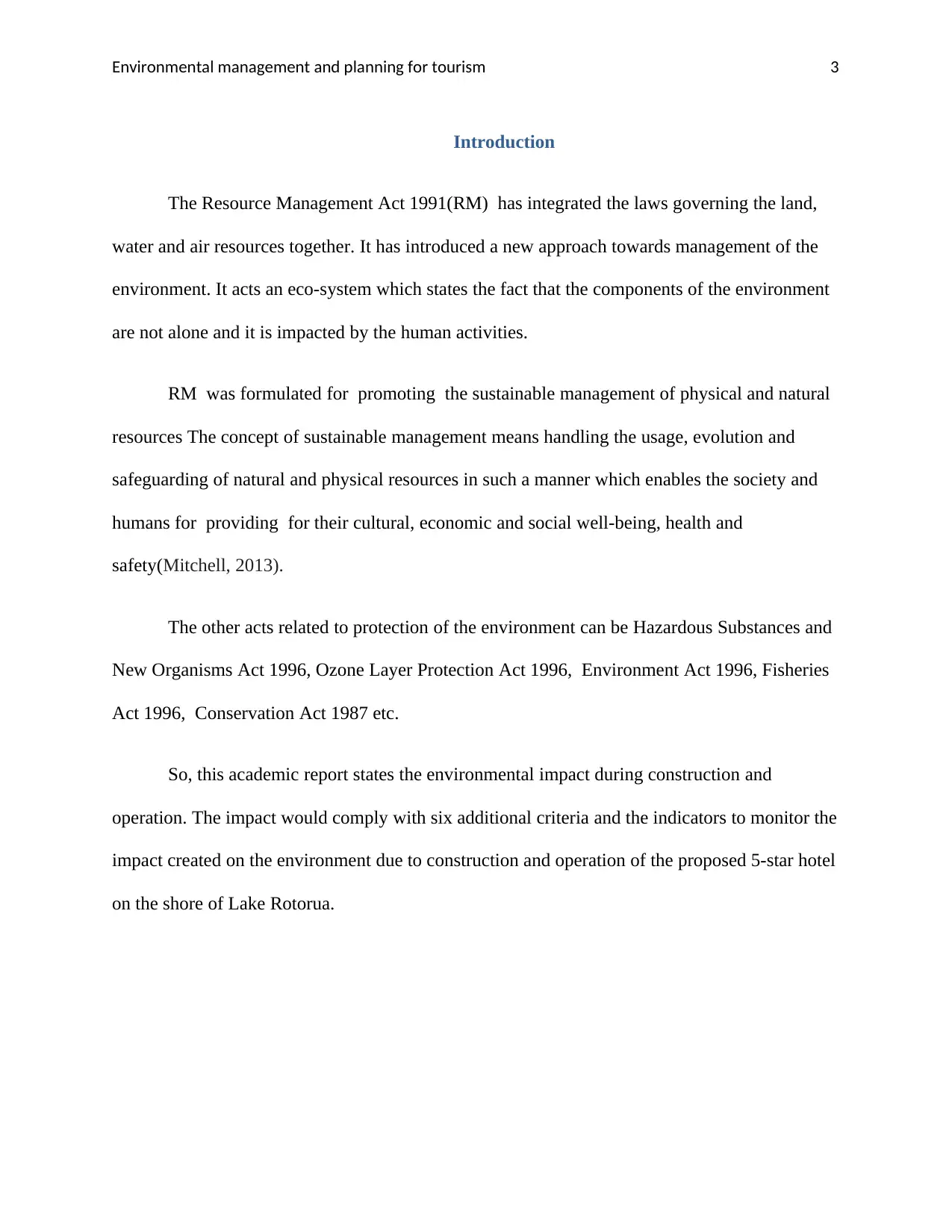
Environmental management and planning for tourism 3
Introduction
The Resource Management Act 1991(RM) has integrated the laws governing the land,
water and air resources together. It has introduced a new approach towards management of the
environment. It acts an eco-system which states the fact that the components of the environment
are not alone and it is impacted by the human activities.
RM was formulated for promoting the sustainable management of physical and natural
resources The concept of sustainable management means handling the usage, evolution and
safeguarding of natural and physical resources in such a manner which enables the society and
humans for providing for their cultural, economic and social well-being, health and
safety(Mitchell, 2013).
The other acts related to protection of the environment can be Hazardous Substances and
New Organisms Act 1996, Ozone Layer Protection Act 1996, Environment Act 1996, Fisheries
Act 1996, Conservation Act 1987 etc.
So, this academic report states the environmental impact during construction and
operation. The impact would comply with six additional criteria and the indicators to monitor the
impact created on the environment due to construction and operation of the proposed 5-star hotel
on the shore of Lake Rotorua.
Introduction
The Resource Management Act 1991(RM) has integrated the laws governing the land,
water and air resources together. It has introduced a new approach towards management of the
environment. It acts an eco-system which states the fact that the components of the environment
are not alone and it is impacted by the human activities.
RM was formulated for promoting the sustainable management of physical and natural
resources The concept of sustainable management means handling the usage, evolution and
safeguarding of natural and physical resources in such a manner which enables the society and
humans for providing for their cultural, economic and social well-being, health and
safety(Mitchell, 2013).
The other acts related to protection of the environment can be Hazardous Substances and
New Organisms Act 1996, Ozone Layer Protection Act 1996, Environment Act 1996, Fisheries
Act 1996, Conservation Act 1987 etc.
So, this academic report states the environmental impact during construction and
operation. The impact would comply with six additional criteria and the indicators to monitor the
impact created on the environment due to construction and operation of the proposed 5-star hotel
on the shore of Lake Rotorua.
Secure Best Marks with AI Grader
Need help grading? Try our AI Grader for instant feedback on your assignments.
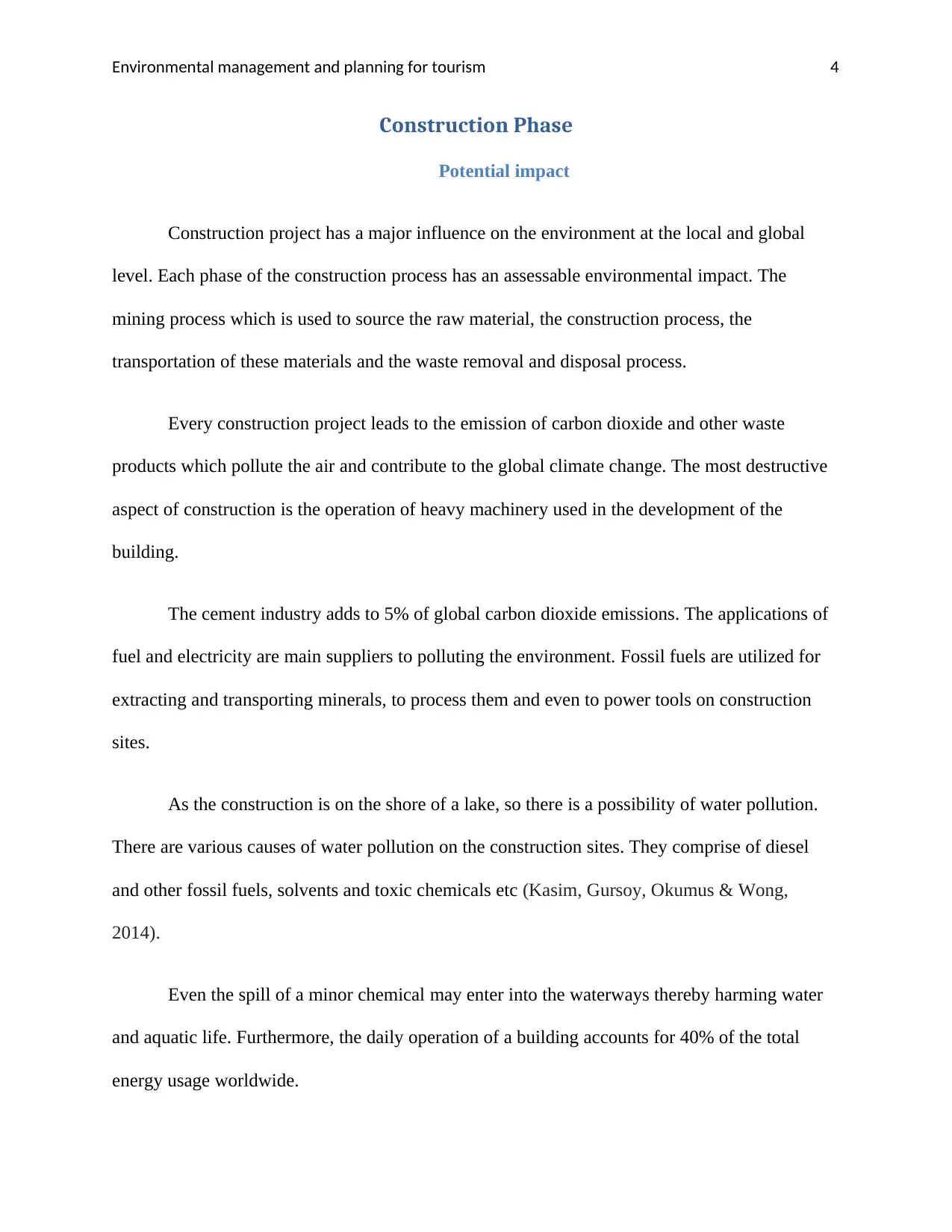
Environmental management and planning for tourism 4
Construction Phase
Potential impact
Construction project has a major influence on the environment at the local and global
level. Each phase of the construction process has an assessable environmental impact. The
mining process which is used to source the raw material, the construction process, the
transportation of these materials and the waste removal and disposal process.
Every construction project leads to the emission of carbon dioxide and other waste
products which pollute the air and contribute to the global climate change. The most destructive
aspect of construction is the operation of heavy machinery used in the development of the
building.
The cement industry adds to 5% of global carbon dioxide emissions. The applications of
fuel and electricity are main suppliers to polluting the environment. Fossil fuels are utilized for
extracting and transporting minerals, to process them and even to power tools on construction
sites.
As the construction is on the shore of a lake, so there is a possibility of water pollution.
There are various causes of water pollution on the construction sites. They comprise of diesel
and other fossil fuels, solvents and toxic chemicals etc (Kasim, Gursoy, Okumus & Wong,
2014).
Even the spill of a minor chemical may enter into the waterways thereby harming water
and aquatic life. Furthermore, the daily operation of a building accounts for 40% of the total
energy usage worldwide.
Construction Phase
Potential impact
Construction project has a major influence on the environment at the local and global
level. Each phase of the construction process has an assessable environmental impact. The
mining process which is used to source the raw material, the construction process, the
transportation of these materials and the waste removal and disposal process.
Every construction project leads to the emission of carbon dioxide and other waste
products which pollute the air and contribute to the global climate change. The most destructive
aspect of construction is the operation of heavy machinery used in the development of the
building.
The cement industry adds to 5% of global carbon dioxide emissions. The applications of
fuel and electricity are main suppliers to polluting the environment. Fossil fuels are utilized for
extracting and transporting minerals, to process them and even to power tools on construction
sites.
As the construction is on the shore of a lake, so there is a possibility of water pollution.
There are various causes of water pollution on the construction sites. They comprise of diesel
and other fossil fuels, solvents and toxic chemicals etc (Kasim, Gursoy, Okumus & Wong,
2014).
Even the spill of a minor chemical may enter into the waterways thereby harming water
and aquatic life. Furthermore, the daily operation of a building accounts for 40% of the total
energy usage worldwide.
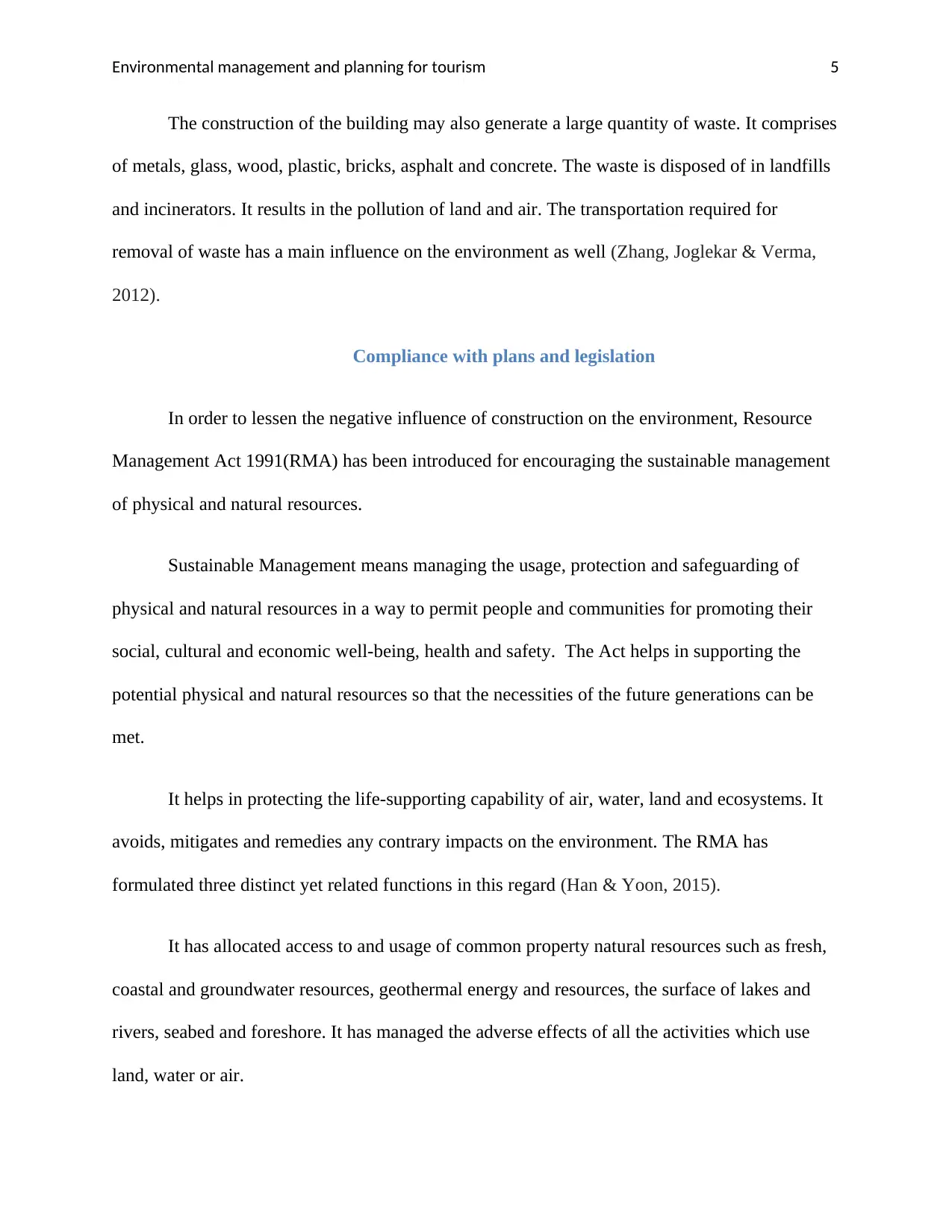
Environmental management and planning for tourism 5
The construction of the building may also generate a large quantity of waste. It comprises
of metals, glass, wood, plastic, bricks, asphalt and concrete. The waste is disposed of in landfills
and incinerators. It results in the pollution of land and air. The transportation required for
removal of waste has a main influence on the environment as well (Zhang, Joglekar & Verma,
2012).
Compliance with plans and legislation
In order to lessen the negative influence of construction on the environment, Resource
Management Act 1991(RMA) has been introduced for encouraging the sustainable management
of physical and natural resources.
Sustainable Management means managing the usage, protection and safeguarding of
physical and natural resources in a way to permit people and communities for promoting their
social, cultural and economic well-being, health and safety. The Act helps in supporting the
potential physical and natural resources so that the necessities of the future generations can be
met.
It helps in protecting the life-supporting capability of air, water, land and ecosystems. It
avoids, mitigates and remedies any contrary impacts on the environment. The RMA has
formulated three distinct yet related functions in this regard (Han & Yoon, 2015).
It has allocated access to and usage of common property natural resources such as fresh,
coastal and groundwater resources, geothermal energy and resources, the surface of lakes and
rivers, seabed and foreshore. It has managed the adverse effects of all the activities which use
land, water or air.
The construction of the building may also generate a large quantity of waste. It comprises
of metals, glass, wood, plastic, bricks, asphalt and concrete. The waste is disposed of in landfills
and incinerators. It results in the pollution of land and air. The transportation required for
removal of waste has a main influence on the environment as well (Zhang, Joglekar & Verma,
2012).
Compliance with plans and legislation
In order to lessen the negative influence of construction on the environment, Resource
Management Act 1991(RMA) has been introduced for encouraging the sustainable management
of physical and natural resources.
Sustainable Management means managing the usage, protection and safeguarding of
physical and natural resources in a way to permit people and communities for promoting their
social, cultural and economic well-being, health and safety. The Act helps in supporting the
potential physical and natural resources so that the necessities of the future generations can be
met.
It helps in protecting the life-supporting capability of air, water, land and ecosystems. It
avoids, mitigates and remedies any contrary impacts on the environment. The RMA has
formulated three distinct yet related functions in this regard (Han & Yoon, 2015).
It has allocated access to and usage of common property natural resources such as fresh,
coastal and groundwater resources, geothermal energy and resources, the surface of lakes and
rivers, seabed and foreshore. It has managed the adverse effects of all the activities which use
land, water or air.
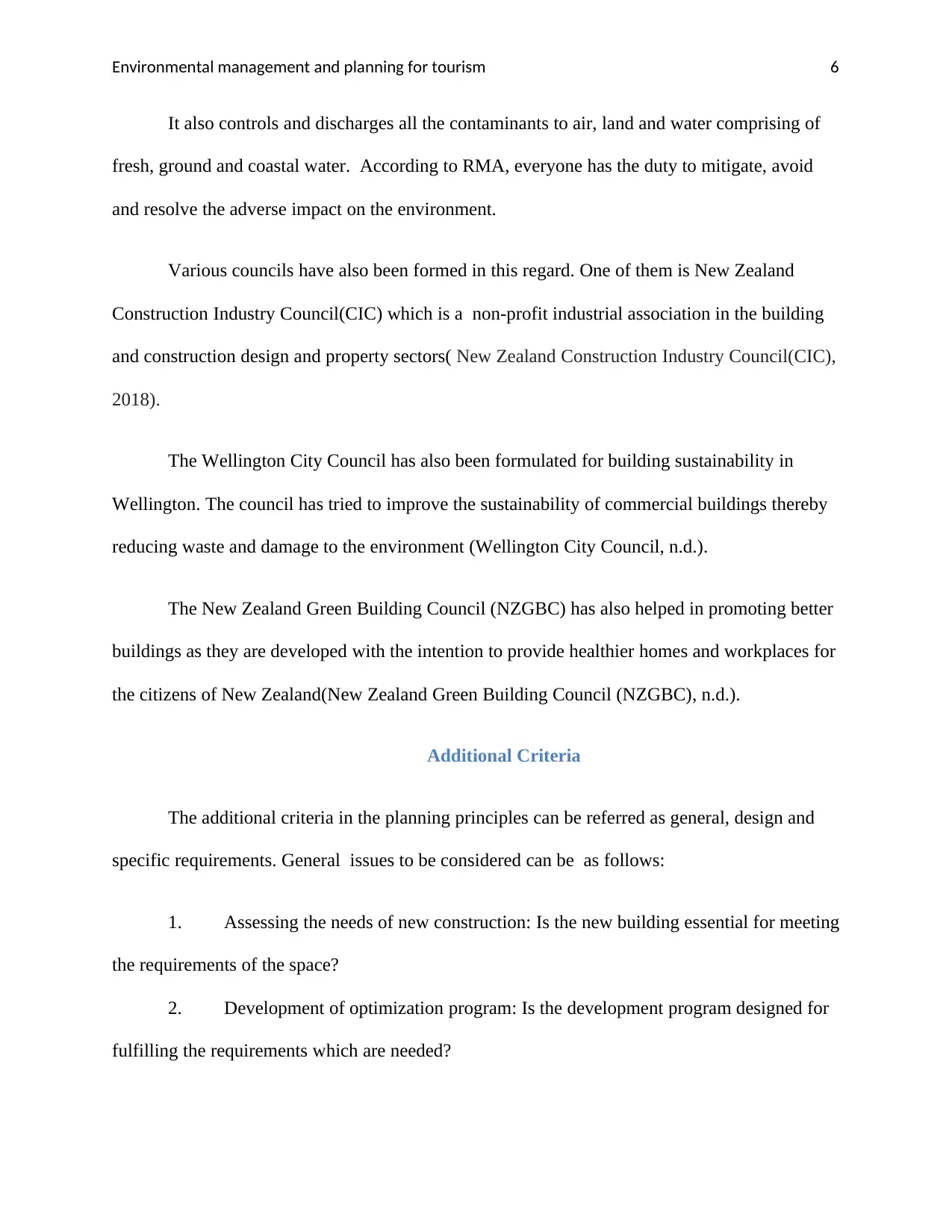
Environmental management and planning for tourism 6
It also controls and discharges all the contaminants to air, land and water comprising of
fresh, ground and coastal water. According to RMA, everyone has the duty to mitigate, avoid
and resolve the adverse impact on the environment.
Various councils have also been formed in this regard. One of them is New Zealand
Construction Industry Council(CIC) which is a non-profit industrial association in the building
and construction design and property sectors( New Zealand Construction Industry Council(CIC),
2018).
The Wellington City Council has also been formulated for building sustainability in
Wellington. The council has tried to improve the sustainability of commercial buildings thereby
reducing waste and damage to the environment (Wellington City Council, n.d.).
The New Zealand Green Building Council (NZGBC) has also helped in promoting better
buildings as they are developed with the intention to provide healthier homes and workplaces for
the citizens of New Zealand(New Zealand Green Building Council (NZGBC), n.d.).
Additional Criteria
The additional criteria in the planning principles can be referred as general, design and
specific requirements. General issues to be considered can be as follows:
1. Assessing the needs of new construction: Is the new building essential for meeting
the requirements of the space?
2. Development of optimization program: Is the development program designed for
fulfilling the requirements which are needed?
It also controls and discharges all the contaminants to air, land and water comprising of
fresh, ground and coastal water. According to RMA, everyone has the duty to mitigate, avoid
and resolve the adverse impact on the environment.
Various councils have also been formed in this regard. One of them is New Zealand
Construction Industry Council(CIC) which is a non-profit industrial association in the building
and construction design and property sectors( New Zealand Construction Industry Council(CIC),
2018).
The Wellington City Council has also been formulated for building sustainability in
Wellington. The council has tried to improve the sustainability of commercial buildings thereby
reducing waste and damage to the environment (Wellington City Council, n.d.).
The New Zealand Green Building Council (NZGBC) has also helped in promoting better
buildings as they are developed with the intention to provide healthier homes and workplaces for
the citizens of New Zealand(New Zealand Green Building Council (NZGBC), n.d.).
Additional Criteria
The additional criteria in the planning principles can be referred as general, design and
specific requirements. General issues to be considered can be as follows:
1. Assessing the needs of new construction: Is the new building essential for meeting
the requirements of the space?
2. Development of optimization program: Is the development program designed for
fulfilling the requirements which are needed?
Paraphrase This Document
Need a fresh take? Get an instant paraphrase of this document with our AI Paraphraser
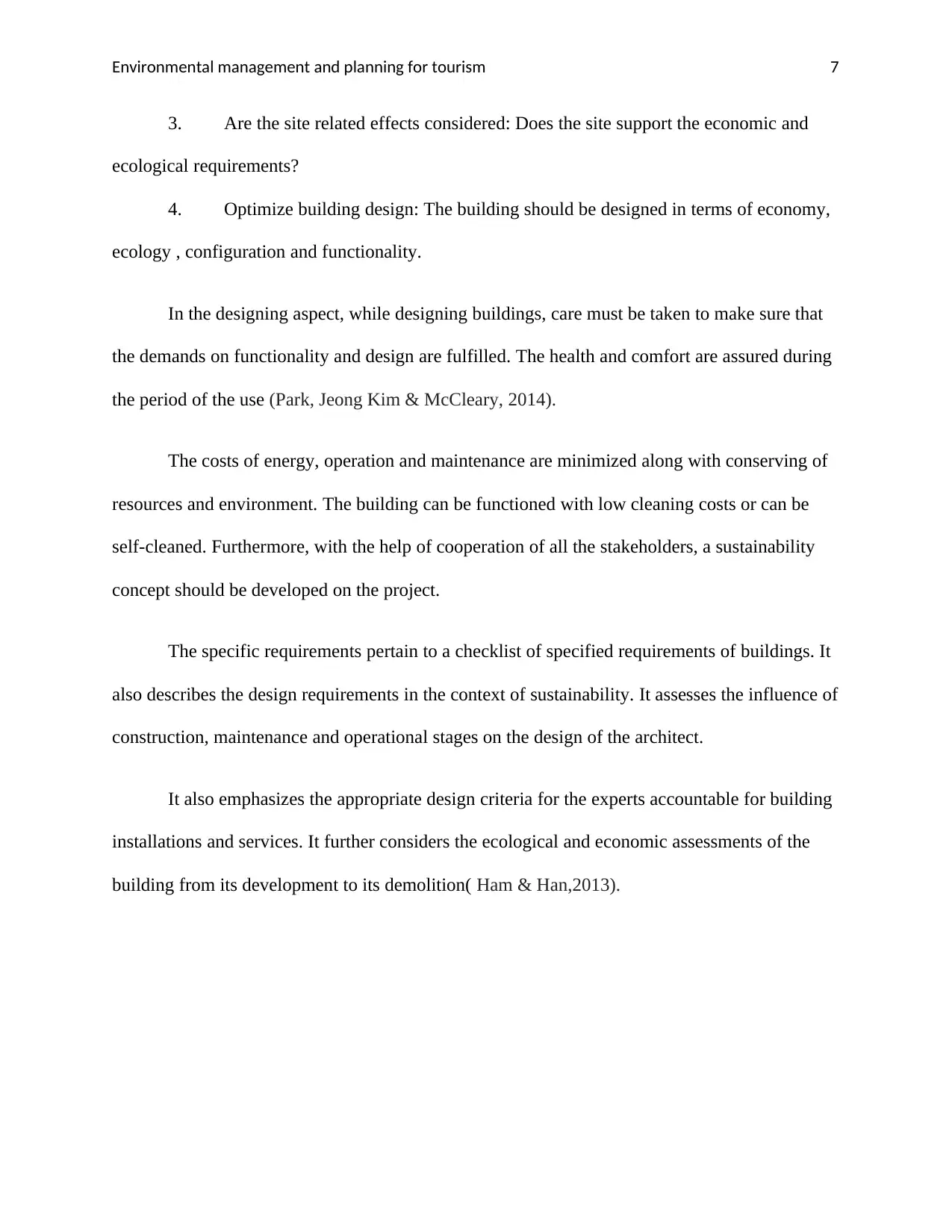
Environmental management and planning for tourism 7
3. Are the site related effects considered: Does the site support the economic and
ecological requirements?
4. Optimize building design: The building should be designed in terms of economy,
ecology , configuration and functionality.
In the designing aspect, while designing buildings, care must be taken to make sure that
the demands on functionality and design are fulfilled. The health and comfort are assured during
the period of the use (Park, Jeong Kim & McCleary, 2014).
The costs of energy, operation and maintenance are minimized along with conserving of
resources and environment. The building can be functioned with low cleaning costs or can be
self-cleaned. Furthermore, with the help of cooperation of all the stakeholders, a sustainability
concept should be developed on the project.
The specific requirements pertain to a checklist of specified requirements of buildings. It
also describes the design requirements in the context of sustainability. It assesses the influence of
construction, maintenance and operational stages on the design of the architect.
It also emphasizes the appropriate design criteria for the experts accountable for building
installations and services. It further considers the ecological and economic assessments of the
building from its development to its demolition( Ham & Han,2013).
3. Are the site related effects considered: Does the site support the economic and
ecological requirements?
4. Optimize building design: The building should be designed in terms of economy,
ecology , configuration and functionality.
In the designing aspect, while designing buildings, care must be taken to make sure that
the demands on functionality and design are fulfilled. The health and comfort are assured during
the period of the use (Park, Jeong Kim & McCleary, 2014).
The costs of energy, operation and maintenance are minimized along with conserving of
resources and environment. The building can be functioned with low cleaning costs or can be
self-cleaned. Furthermore, with the help of cooperation of all the stakeholders, a sustainability
concept should be developed on the project.
The specific requirements pertain to a checklist of specified requirements of buildings. It
also describes the design requirements in the context of sustainability. It assesses the influence of
construction, maintenance and operational stages on the design of the architect.
It also emphasizes the appropriate design criteria for the experts accountable for building
installations and services. It further considers the ecological and economic assessments of the
building from its development to its demolition( Ham & Han,2013).
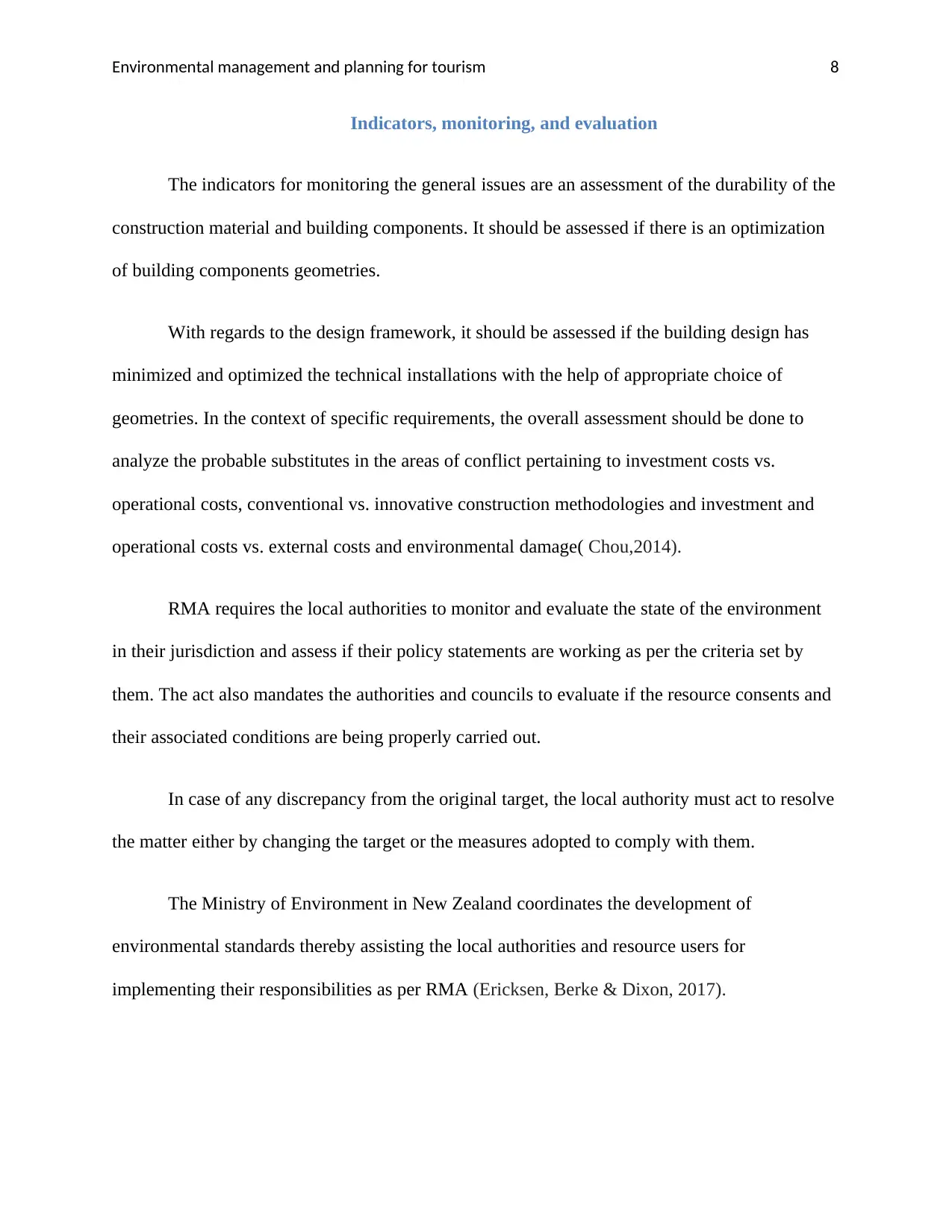
Environmental management and planning for tourism 8
Indicators, monitoring, and evaluation
The indicators for monitoring the general issues are an assessment of the durability of the
construction material and building components. It should be assessed if there is an optimization
of building components geometries.
With regards to the design framework, it should be assessed if the building design has
minimized and optimized the technical installations with the help of appropriate choice of
geometries. In the context of specific requirements, the overall assessment should be done to
analyze the probable substitutes in the areas of conflict pertaining to investment costs vs.
operational costs, conventional vs. innovative construction methodologies and investment and
operational costs vs. external costs and environmental damage( Chou,2014).
RMA requires the local authorities to monitor and evaluate the state of the environment
in their jurisdiction and assess if their policy statements are working as per the criteria set by
them. The act also mandates the authorities and councils to evaluate if the resource consents and
their associated conditions are being properly carried out.
In case of any discrepancy from the original target, the local authority must act to resolve
the matter either by changing the target or the measures adopted to comply with them.
The Ministry of Environment in New Zealand coordinates the development of
environmental standards thereby assisting the local authorities and resource users for
implementing their responsibilities as per RMA (Ericksen, Berke & Dixon, 2017).
Indicators, monitoring, and evaluation
The indicators for monitoring the general issues are an assessment of the durability of the
construction material and building components. It should be assessed if there is an optimization
of building components geometries.
With regards to the design framework, it should be assessed if the building design has
minimized and optimized the technical installations with the help of appropriate choice of
geometries. In the context of specific requirements, the overall assessment should be done to
analyze the probable substitutes in the areas of conflict pertaining to investment costs vs.
operational costs, conventional vs. innovative construction methodologies and investment and
operational costs vs. external costs and environmental damage( Chou,2014).
RMA requires the local authorities to monitor and evaluate the state of the environment
in their jurisdiction and assess if their policy statements are working as per the criteria set by
them. The act also mandates the authorities and councils to evaluate if the resource consents and
their associated conditions are being properly carried out.
In case of any discrepancy from the original target, the local authority must act to resolve
the matter either by changing the target or the measures adopted to comply with them.
The Ministry of Environment in New Zealand coordinates the development of
environmental standards thereby assisting the local authorities and resource users for
implementing their responsibilities as per RMA (Ericksen, Berke & Dixon, 2017).
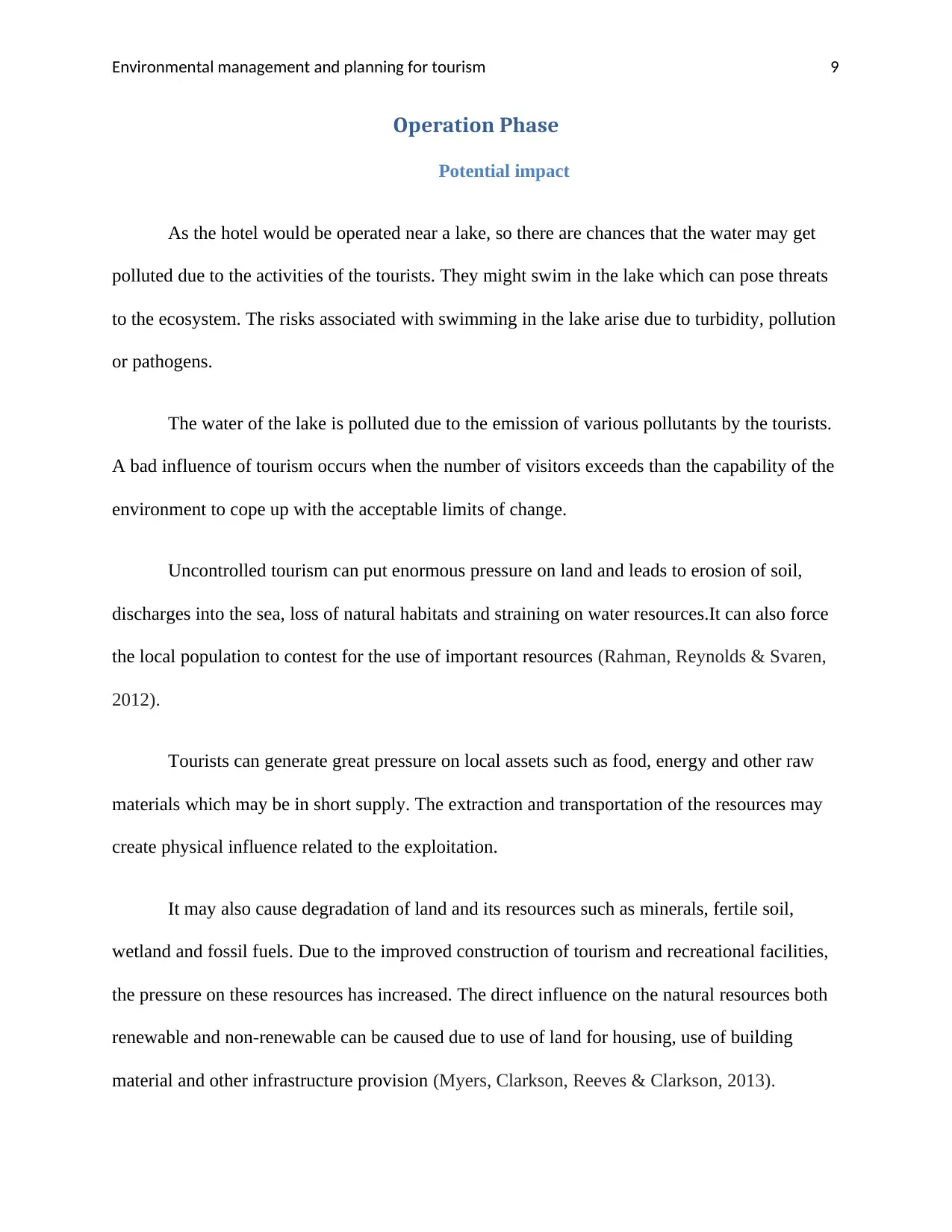
Environmental management and planning for tourism 9
Operation Phase
Potential impact
As the hotel would be operated near a lake, so there are chances that the water may get
polluted due to the activities of the tourists. They might swim in the lake which can pose threats
to the ecosystem. The risks associated with swimming in the lake arise due to turbidity, pollution
or pathogens.
The water of the lake is polluted due to the emission of various pollutants by the tourists.
A bad influence of tourism occurs when the number of visitors exceeds than the capability of the
environment to cope up with the acceptable limits of change.
Uncontrolled tourism can put enormous pressure on land and leads to erosion of soil,
discharges into the sea, loss of natural habitats and straining on water resources.It can also force
the local population to contest for the use of important resources (Rahman, Reynolds & Svaren,
2012).
Tourists can generate great pressure on local assets such as food, energy and other raw
materials which may be in short supply. The extraction and transportation of the resources may
create physical influence related to the exploitation.
It may also cause degradation of land and its resources such as minerals, fertile soil,
wetland and fossil fuels. Due to the improved construction of tourism and recreational facilities,
the pressure on these resources has increased. The direct influence on the natural resources both
renewable and non-renewable can be caused due to use of land for housing, use of building
material and other infrastructure provision (Myers, Clarkson, Reeves & Clarkson, 2013).
Operation Phase
Potential impact
As the hotel would be operated near a lake, so there are chances that the water may get
polluted due to the activities of the tourists. They might swim in the lake which can pose threats
to the ecosystem. The risks associated with swimming in the lake arise due to turbidity, pollution
or pathogens.
The water of the lake is polluted due to the emission of various pollutants by the tourists.
A bad influence of tourism occurs when the number of visitors exceeds than the capability of the
environment to cope up with the acceptable limits of change.
Uncontrolled tourism can put enormous pressure on land and leads to erosion of soil,
discharges into the sea, loss of natural habitats and straining on water resources.It can also force
the local population to contest for the use of important resources (Rahman, Reynolds & Svaren,
2012).
Tourists can generate great pressure on local assets such as food, energy and other raw
materials which may be in short supply. The extraction and transportation of the resources may
create physical influence related to the exploitation.
It may also cause degradation of land and its resources such as minerals, fertile soil,
wetland and fossil fuels. Due to the improved construction of tourism and recreational facilities,
the pressure on these resources has increased. The direct influence on the natural resources both
renewable and non-renewable can be caused due to use of land for housing, use of building
material and other infrastructure provision (Myers, Clarkson, Reeves & Clarkson, 2013).
Secure Best Marks with AI Grader
Need help grading? Try our AI Grader for instant feedback on your assignments.
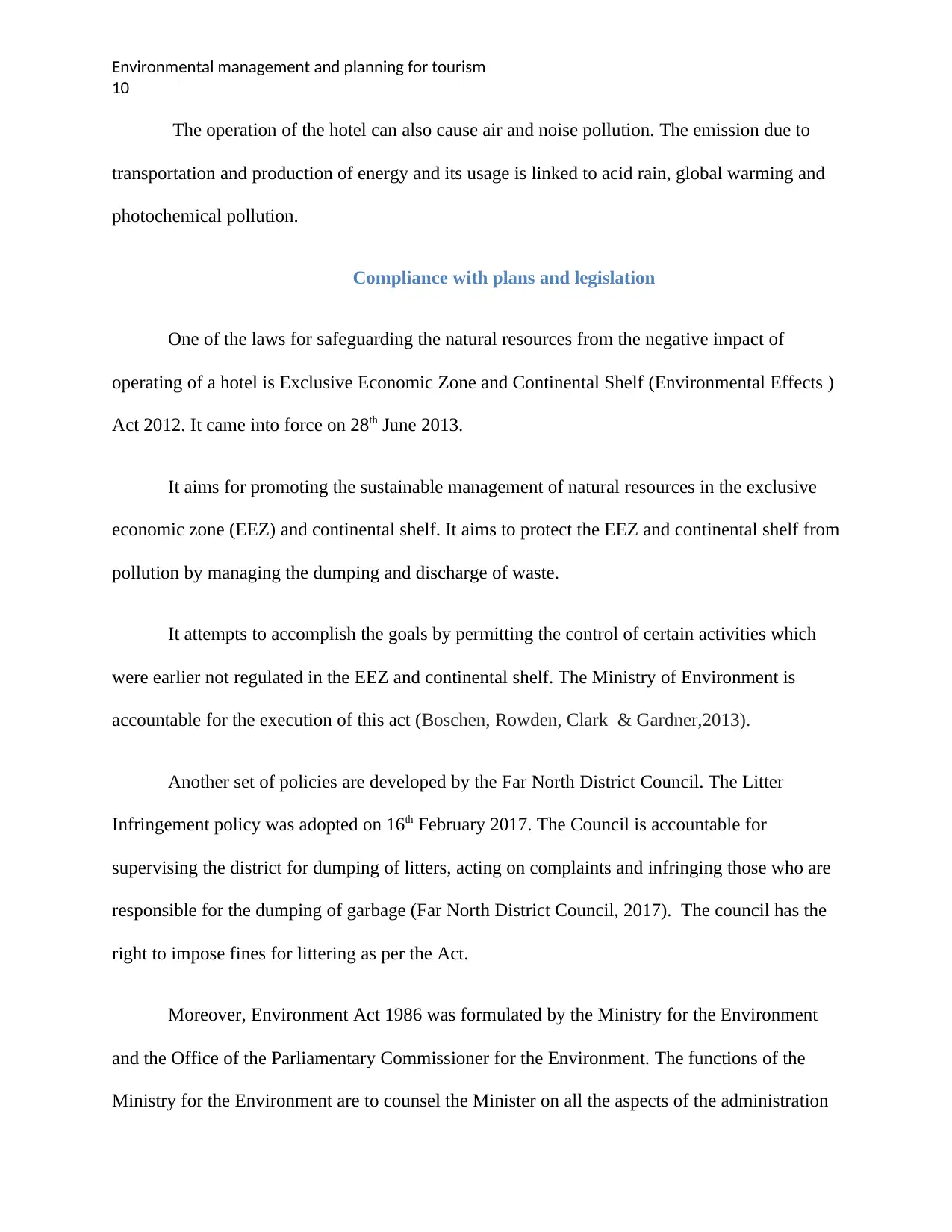
Environmental management and planning for tourism
10
The operation of the hotel can also cause air and noise pollution. The emission due to
transportation and production of energy and its usage is linked to acid rain, global warming and
photochemical pollution.
Compliance with plans and legislation
One of the laws for safeguarding the natural resources from the negative impact of
operating of a hotel is Exclusive Economic Zone and Continental Shelf (Environmental Effects )
Act 2012. It came into force on 28th June 2013.
It aims for promoting the sustainable management of natural resources in the exclusive
economic zone (EEZ) and continental shelf. It aims to protect the EEZ and continental shelf from
pollution by managing the dumping and discharge of waste.
It attempts to accomplish the goals by permitting the control of certain activities which
were earlier not regulated in the EEZ and continental shelf. The Ministry of Environment is
accountable for the execution of this act (Boschen, Rowden, Clark & Gardner,2013).
Another set of policies are developed by the Far North District Council. The Litter
Infringement policy was adopted on 16th February 2017. The Council is accountable for
supervising the district for dumping of litters, acting on complaints and infringing those who are
responsible for the dumping of garbage (Far North District Council, 2017). The council has the
right to impose fines for littering as per the Act.
Moreover, Environment Act 1986 was formulated by the Ministry for the Environment
and the Office of the Parliamentary Commissioner for the Environment. The functions of the
Ministry for the Environment are to counsel the Minister on all the aspects of the administration
10
The operation of the hotel can also cause air and noise pollution. The emission due to
transportation and production of energy and its usage is linked to acid rain, global warming and
photochemical pollution.
Compliance with plans and legislation
One of the laws for safeguarding the natural resources from the negative impact of
operating of a hotel is Exclusive Economic Zone and Continental Shelf (Environmental Effects )
Act 2012. It came into force on 28th June 2013.
It aims for promoting the sustainable management of natural resources in the exclusive
economic zone (EEZ) and continental shelf. It aims to protect the EEZ and continental shelf from
pollution by managing the dumping and discharge of waste.
It attempts to accomplish the goals by permitting the control of certain activities which
were earlier not regulated in the EEZ and continental shelf. The Ministry of Environment is
accountable for the execution of this act (Boschen, Rowden, Clark & Gardner,2013).
Another set of policies are developed by the Far North District Council. The Litter
Infringement policy was adopted on 16th February 2017. The Council is accountable for
supervising the district for dumping of litters, acting on complaints and infringing those who are
responsible for the dumping of garbage (Far North District Council, 2017). The council has the
right to impose fines for littering as per the Act.
Moreover, Environment Act 1986 was formulated by the Ministry for the Environment
and the Office of the Parliamentary Commissioner for the Environment. The functions of the
Ministry for the Environment are to counsel the Minister on all the aspects of the administration
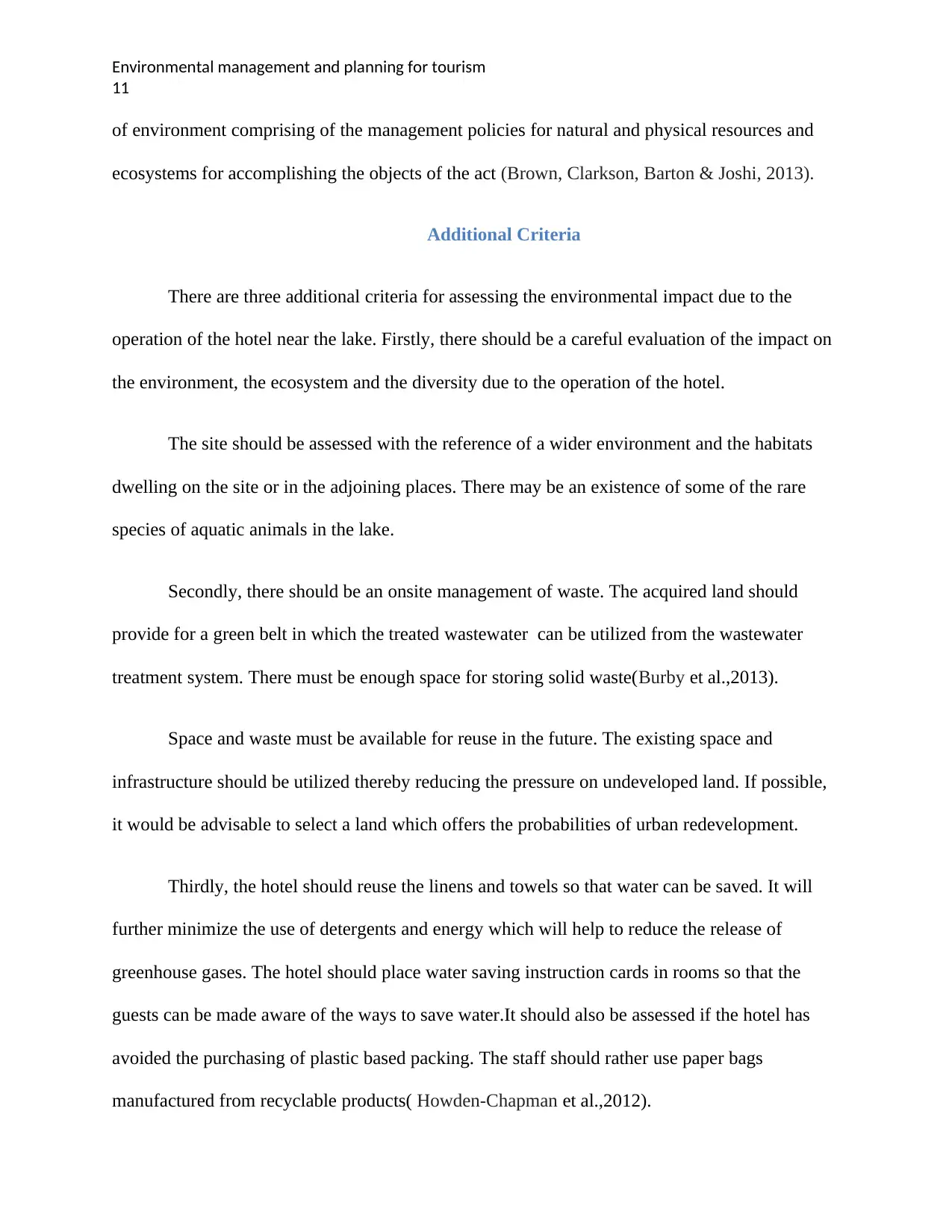
Environmental management and planning for tourism
11
of environment comprising of the management policies for natural and physical resources and
ecosystems for accomplishing the objects of the act (Brown, Clarkson, Barton & Joshi, 2013).
Additional Criteria
There are three additional criteria for assessing the environmental impact due to the
operation of the hotel near the lake. Firstly, there should be a careful evaluation of the impact on
the environment, the ecosystem and the diversity due to the operation of the hotel.
The site should be assessed with the reference of a wider environment and the habitats
dwelling on the site or in the adjoining places. There may be an existence of some of the rare
species of aquatic animals in the lake.
Secondly, there should be an onsite management of waste. The acquired land should
provide for a green belt in which the treated wastewater can be utilized from the wastewater
treatment system. There must be enough space for storing solid waste(Burby et al.,2013).
Space and waste must be available for reuse in the future. The existing space and
infrastructure should be utilized thereby reducing the pressure on undeveloped land. If possible,
it would be advisable to select a land which offers the probabilities of urban redevelopment.
Thirdly, the hotel should reuse the linens and towels so that water can be saved. It will
further minimize the use of detergents and energy which will help to reduce the release of
greenhouse gases. The hotel should place water saving instruction cards in rooms so that the
guests can be made aware of the ways to save water.It should also be assessed if the hotel has
avoided the purchasing of plastic based packing. The staff should rather use paper bags
manufactured from recyclable products( Howden-Chapman et al.,2012).
11
of environment comprising of the management policies for natural and physical resources and
ecosystems for accomplishing the objects of the act (Brown, Clarkson, Barton & Joshi, 2013).
Additional Criteria
There are three additional criteria for assessing the environmental impact due to the
operation of the hotel near the lake. Firstly, there should be a careful evaluation of the impact on
the environment, the ecosystem and the diversity due to the operation of the hotel.
The site should be assessed with the reference of a wider environment and the habitats
dwelling on the site or in the adjoining places. There may be an existence of some of the rare
species of aquatic animals in the lake.
Secondly, there should be an onsite management of waste. The acquired land should
provide for a green belt in which the treated wastewater can be utilized from the wastewater
treatment system. There must be enough space for storing solid waste(Burby et al.,2013).
Space and waste must be available for reuse in the future. The existing space and
infrastructure should be utilized thereby reducing the pressure on undeveloped land. If possible,
it would be advisable to select a land which offers the probabilities of urban redevelopment.
Thirdly, the hotel should reuse the linens and towels so that water can be saved. It will
further minimize the use of detergents and energy which will help to reduce the release of
greenhouse gases. The hotel should place water saving instruction cards in rooms so that the
guests can be made aware of the ways to save water.It should also be assessed if the hotel has
avoided the purchasing of plastic based packing. The staff should rather use paper bags
manufactured from recyclable products( Howden-Chapman et al.,2012).
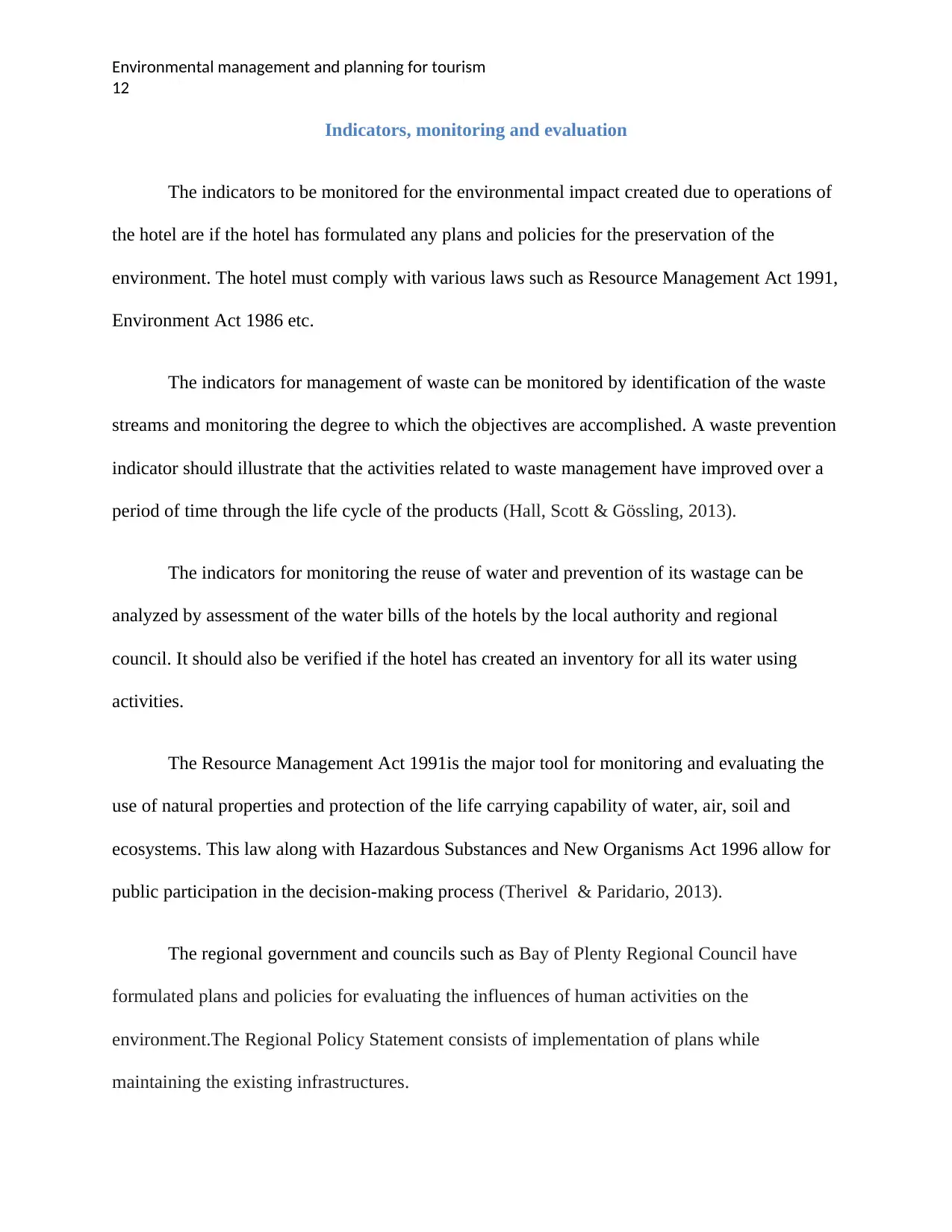
Environmental management and planning for tourism
12
Indicators, monitoring and evaluation
The indicators to be monitored for the environmental impact created due to operations of
the hotel are if the hotel has formulated any plans and policies for the preservation of the
environment. The hotel must comply with various laws such as Resource Management Act 1991,
Environment Act 1986 etc.
The indicators for management of waste can be monitored by identification of the waste
streams and monitoring the degree to which the objectives are accomplished. A waste prevention
indicator should illustrate that the activities related to waste management have improved over a
period of time through the life cycle of the products (Hall, Scott & Gössling, 2013).
The indicators for monitoring the reuse of water and prevention of its wastage can be
analyzed by assessment of the water bills of the hotels by the local authority and regional
council. It should also be verified if the hotel has created an inventory for all its water using
activities.
The Resource Management Act 1991is the major tool for monitoring and evaluating the
use of natural properties and protection of the life carrying capability of water, air, soil and
ecosystems. This law along with Hazardous Substances and New Organisms Act 1996 allow for
public participation in the decision-making process (Therivel & Paridario, 2013).
The regional government and councils such as Bay of Plenty Regional Council have
formulated plans and policies for evaluating the influences of human activities on the
environment.The Regional Policy Statement consists of implementation of plans while
maintaining the existing infrastructures.
12
Indicators, monitoring and evaluation
The indicators to be monitored for the environmental impact created due to operations of
the hotel are if the hotel has formulated any plans and policies for the preservation of the
environment. The hotel must comply with various laws such as Resource Management Act 1991,
Environment Act 1986 etc.
The indicators for management of waste can be monitored by identification of the waste
streams and monitoring the degree to which the objectives are accomplished. A waste prevention
indicator should illustrate that the activities related to waste management have improved over a
period of time through the life cycle of the products (Hall, Scott & Gössling, 2013).
The indicators for monitoring the reuse of water and prevention of its wastage can be
analyzed by assessment of the water bills of the hotels by the local authority and regional
council. It should also be verified if the hotel has created an inventory for all its water using
activities.
The Resource Management Act 1991is the major tool for monitoring and evaluating the
use of natural properties and protection of the life carrying capability of water, air, soil and
ecosystems. This law along with Hazardous Substances and New Organisms Act 1996 allow for
public participation in the decision-making process (Therivel & Paridario, 2013).
The regional government and councils such as Bay of Plenty Regional Council have
formulated plans and policies for evaluating the influences of human activities on the
environment.The Regional Policy Statement consists of implementation of plans while
maintaining the existing infrastructures.
Paraphrase This Document
Need a fresh take? Get an instant paraphrase of this document with our AI Paraphraser
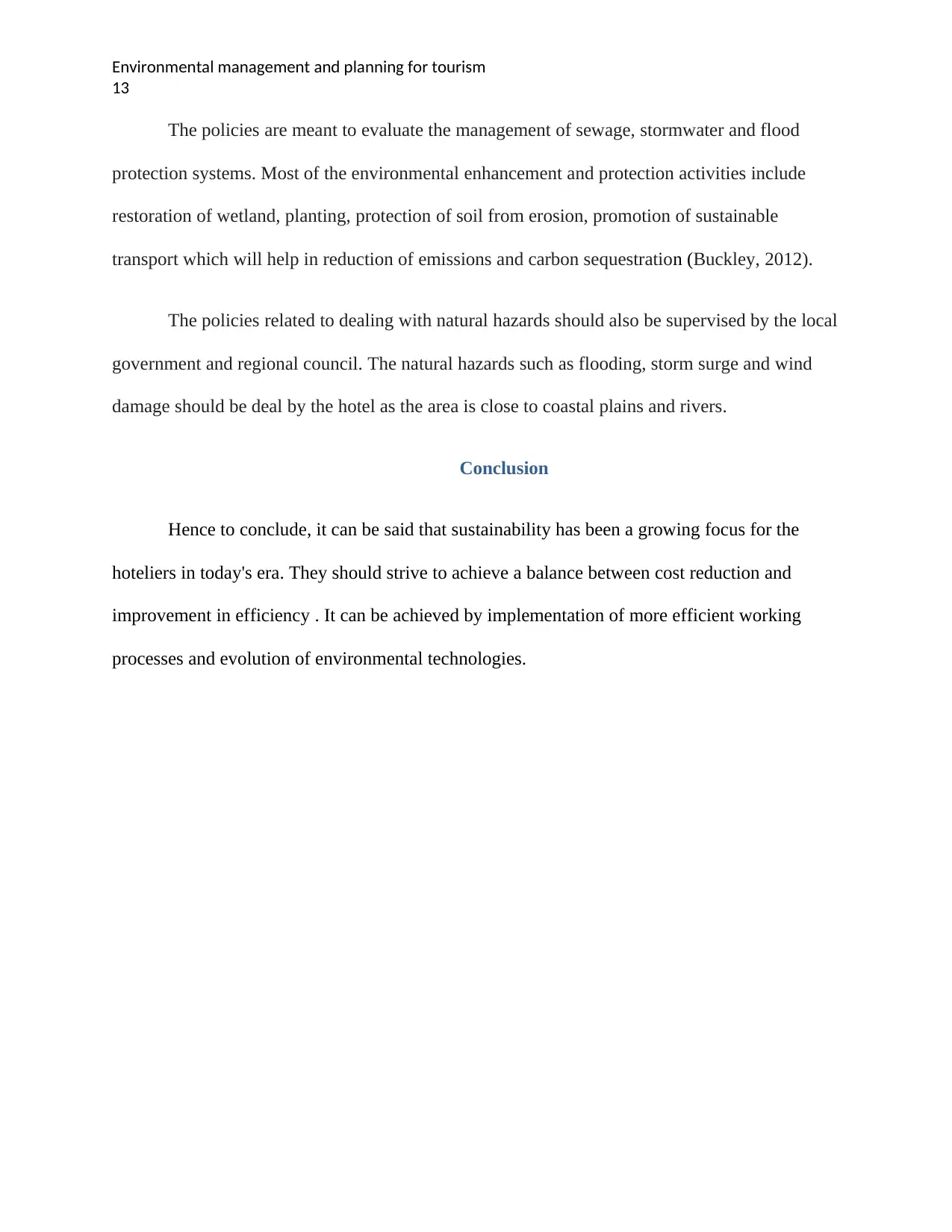
Environmental management and planning for tourism
13
The policies are meant to evaluate the management of sewage, stormwater and flood
protection systems. Most of the environmental enhancement and protection activities include
restoration of wetland, planting, protection of soil from erosion, promotion of sustainable
transport which will help in reduction of emissions and carbon sequestration (Buckley, 2012).
The policies related to dealing with natural hazards should also be supervised by the local
government and regional council. The natural hazards such as flooding, storm surge and wind
damage should be deal by the hotel as the area is close to coastal plains and rivers.
Conclusion
Hence to conclude, it can be said that sustainability has been a growing focus for the
hoteliers in today's era. They should strive to achieve a balance between cost reduction and
improvement in efficiency . It can be achieved by implementation of more efficient working
processes and evolution of environmental technologies.
13
The policies are meant to evaluate the management of sewage, stormwater and flood
protection systems. Most of the environmental enhancement and protection activities include
restoration of wetland, planting, protection of soil from erosion, promotion of sustainable
transport which will help in reduction of emissions and carbon sequestration (Buckley, 2012).
The policies related to dealing with natural hazards should also be supervised by the local
government and regional council. The natural hazards such as flooding, storm surge and wind
damage should be deal by the hotel as the area is close to coastal plains and rivers.
Conclusion
Hence to conclude, it can be said that sustainability has been a growing focus for the
hoteliers in today's era. They should strive to achieve a balance between cost reduction and
improvement in efficiency . It can be achieved by implementation of more efficient working
processes and evolution of environmental technologies.
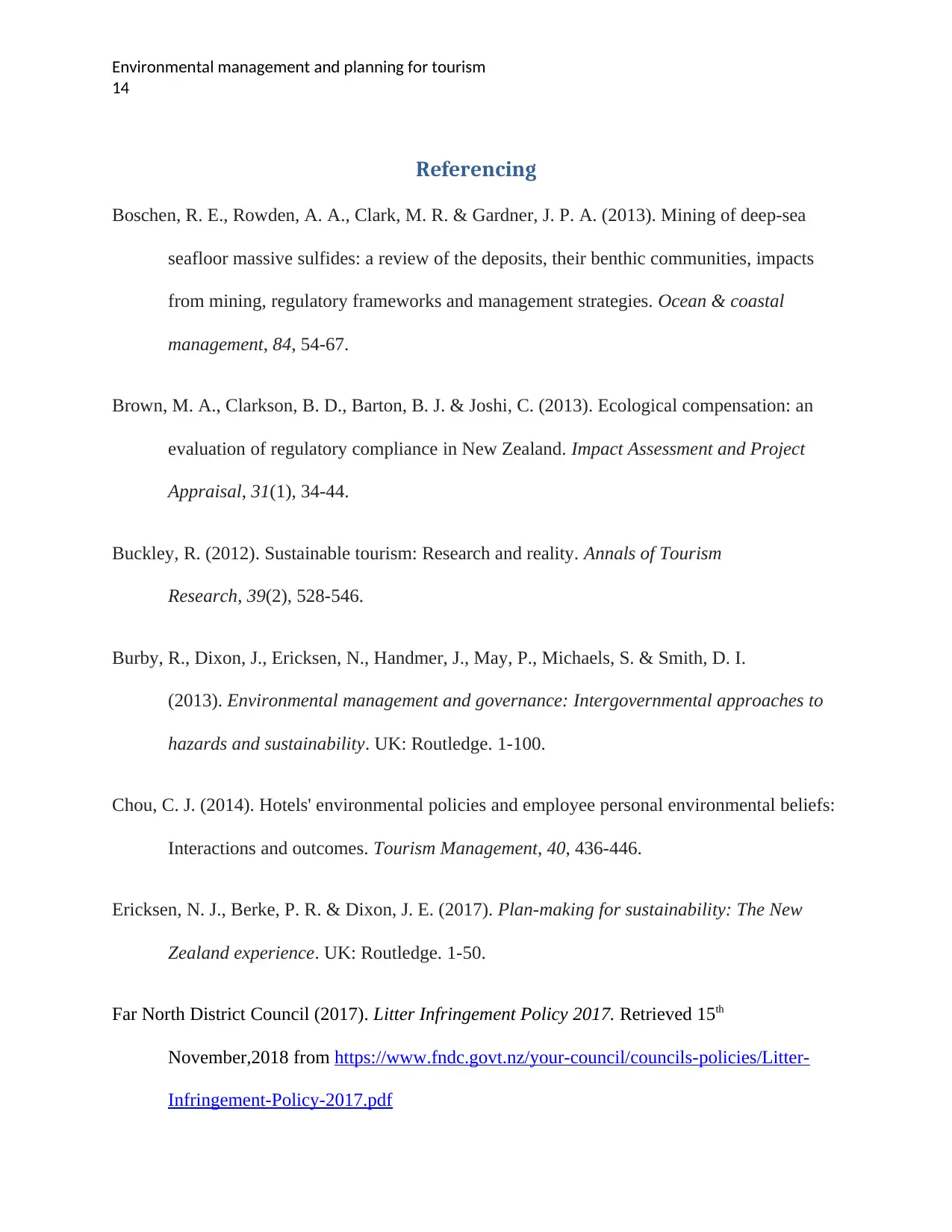
Environmental management and planning for tourism
14
Referencing
Boschen, R. E., Rowden, A. A., Clark, M. R. & Gardner, J. P. A. (2013). Mining of deep-sea
seafloor massive sulfides: a review of the deposits, their benthic communities, impacts
from mining, regulatory frameworks and management strategies. Ocean & coastal
management, 84, 54-67.
Brown, M. A., Clarkson, B. D., Barton, B. J. & Joshi, C. (2013). Ecological compensation: an
evaluation of regulatory compliance in New Zealand. Impact Assessment and Project
Appraisal, 31(1), 34-44.
Buckley, R. (2012). Sustainable tourism: Research and reality. Annals of Tourism
Research, 39(2), 528-546.
Burby, R., Dixon, J., Ericksen, N., Handmer, J., May, P., Michaels, S. & Smith, D. I.
(2013). Environmental management and governance: Intergovernmental approaches to
hazards and sustainability. UK: Routledge. 1-100.
Chou, C. J. (2014). Hotels' environmental policies and employee personal environmental beliefs:
Interactions and outcomes. Tourism Management, 40, 436-446.
Ericksen, N. J., Berke, P. R. & Dixon, J. E. (2017). Plan-making for sustainability: The New
Zealand experience. UK: Routledge. 1-50.
Far North District Council (2017). Litter Infringement Policy 2017. Retrieved 15th
November,2018 from https://www.fndc.govt.nz/your-council/councils-policies/Litter-
Infringement-Policy-2017.pdf
14
Referencing
Boschen, R. E., Rowden, A. A., Clark, M. R. & Gardner, J. P. A. (2013). Mining of deep-sea
seafloor massive sulfides: a review of the deposits, their benthic communities, impacts
from mining, regulatory frameworks and management strategies. Ocean & coastal
management, 84, 54-67.
Brown, M. A., Clarkson, B. D., Barton, B. J. & Joshi, C. (2013). Ecological compensation: an
evaluation of regulatory compliance in New Zealand. Impact Assessment and Project
Appraisal, 31(1), 34-44.
Buckley, R. (2012). Sustainable tourism: Research and reality. Annals of Tourism
Research, 39(2), 528-546.
Burby, R., Dixon, J., Ericksen, N., Handmer, J., May, P., Michaels, S. & Smith, D. I.
(2013). Environmental management and governance: Intergovernmental approaches to
hazards and sustainability. UK: Routledge. 1-100.
Chou, C. J. (2014). Hotels' environmental policies and employee personal environmental beliefs:
Interactions and outcomes. Tourism Management, 40, 436-446.
Ericksen, N. J., Berke, P. R. & Dixon, J. E. (2017). Plan-making for sustainability: The New
Zealand experience. UK: Routledge. 1-50.
Far North District Council (2017). Litter Infringement Policy 2017. Retrieved 15th
November,2018 from https://www.fndc.govt.nz/your-council/councils-policies/Litter-
Infringement-Policy-2017.pdf
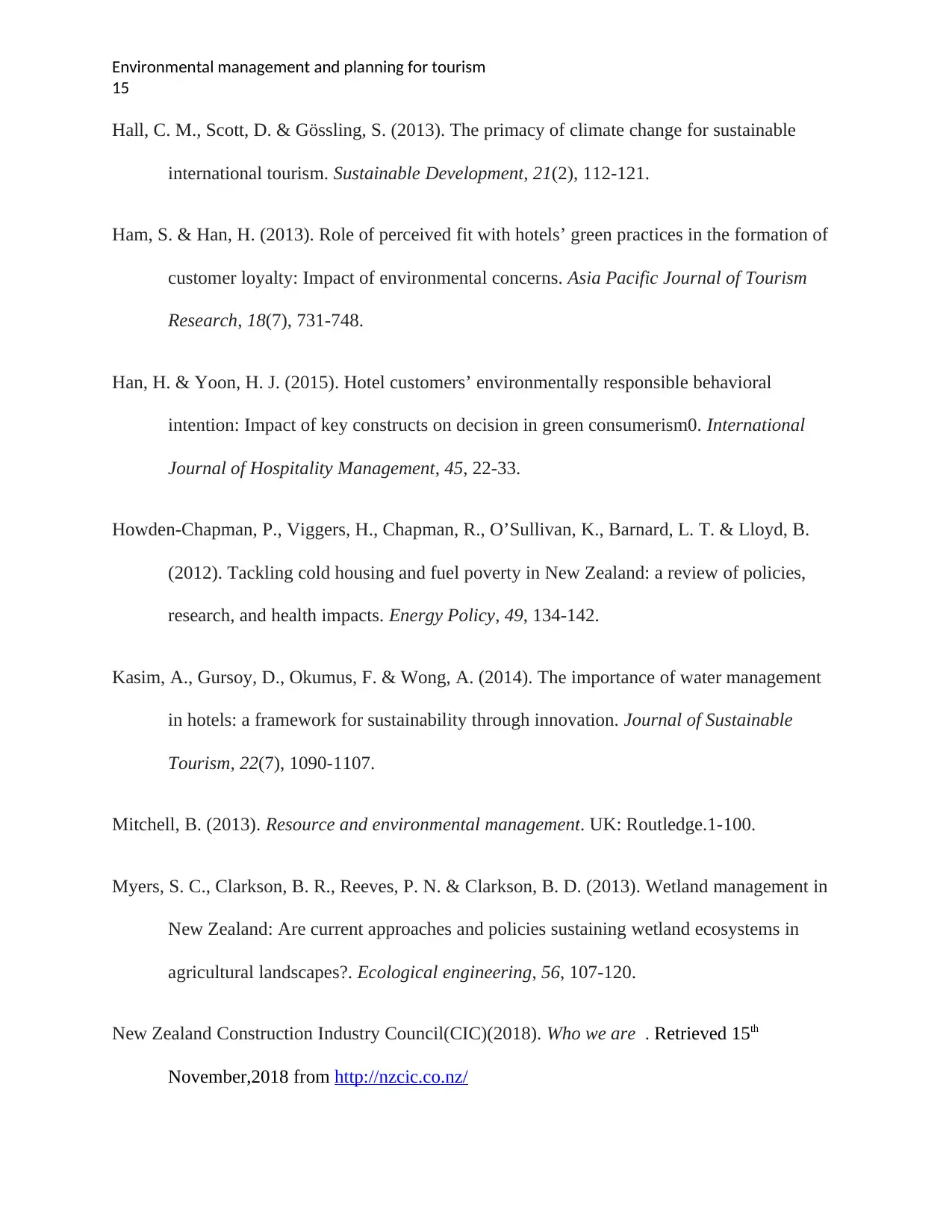
Environmental management and planning for tourism
15
Hall, C. M., Scott, D. & Gössling, S. (2013). The primacy of climate change for sustainable
international tourism. Sustainable Development, 21(2), 112-121.
Ham, S. & Han, H. (2013). Role of perceived fit with hotels’ green practices in the formation of
customer loyalty: Impact of environmental concerns. Asia Pacific Journal of Tourism
Research, 18(7), 731-748.
Han, H. & Yoon, H. J. (2015). Hotel customers’ environmentally responsible behavioral
intention: Impact of key constructs on decision in green consumerism0. International
Journal of Hospitality Management, 45, 22-33.
Howden-Chapman, P., Viggers, H., Chapman, R., O’Sullivan, K., Barnard, L. T. & Lloyd, B.
(2012). Tackling cold housing and fuel poverty in New Zealand: a review of policies,
research, and health impacts. Energy Policy, 49, 134-142.
Kasim, A., Gursoy, D., Okumus, F. & Wong, A. (2014). The importance of water management
in hotels: a framework for sustainability through innovation. Journal of Sustainable
Tourism, 22(7), 1090-1107.
Mitchell, B. (2013). Resource and environmental management. UK: Routledge.1-100.
Myers, S. C., Clarkson, B. R., Reeves, P. N. & Clarkson, B. D. (2013). Wetland management in
New Zealand: Are current approaches and policies sustaining wetland ecosystems in
agricultural landscapes?. Ecological engineering, 56, 107-120.
New Zealand Construction Industry Council(CIC)(2018). Who we are . Retrieved 15th
November,2018 from http://nzcic.co.nz/
15
Hall, C. M., Scott, D. & Gössling, S. (2013). The primacy of climate change for sustainable
international tourism. Sustainable Development, 21(2), 112-121.
Ham, S. & Han, H. (2013). Role of perceived fit with hotels’ green practices in the formation of
customer loyalty: Impact of environmental concerns. Asia Pacific Journal of Tourism
Research, 18(7), 731-748.
Han, H. & Yoon, H. J. (2015). Hotel customers’ environmentally responsible behavioral
intention: Impact of key constructs on decision in green consumerism0. International
Journal of Hospitality Management, 45, 22-33.
Howden-Chapman, P., Viggers, H., Chapman, R., O’Sullivan, K., Barnard, L. T. & Lloyd, B.
(2012). Tackling cold housing and fuel poverty in New Zealand: a review of policies,
research, and health impacts. Energy Policy, 49, 134-142.
Kasim, A., Gursoy, D., Okumus, F. & Wong, A. (2014). The importance of water management
in hotels: a framework for sustainability through innovation. Journal of Sustainable
Tourism, 22(7), 1090-1107.
Mitchell, B. (2013). Resource and environmental management. UK: Routledge.1-100.
Myers, S. C., Clarkson, B. R., Reeves, P. N. & Clarkson, B. D. (2013). Wetland management in
New Zealand: Are current approaches and policies sustaining wetland ecosystems in
agricultural landscapes?. Ecological engineering, 56, 107-120.
New Zealand Construction Industry Council(CIC)(2018). Who we are . Retrieved 15th
November,2018 from http://nzcic.co.nz/
Secure Best Marks with AI Grader
Need help grading? Try our AI Grader for instant feedback on your assignments.
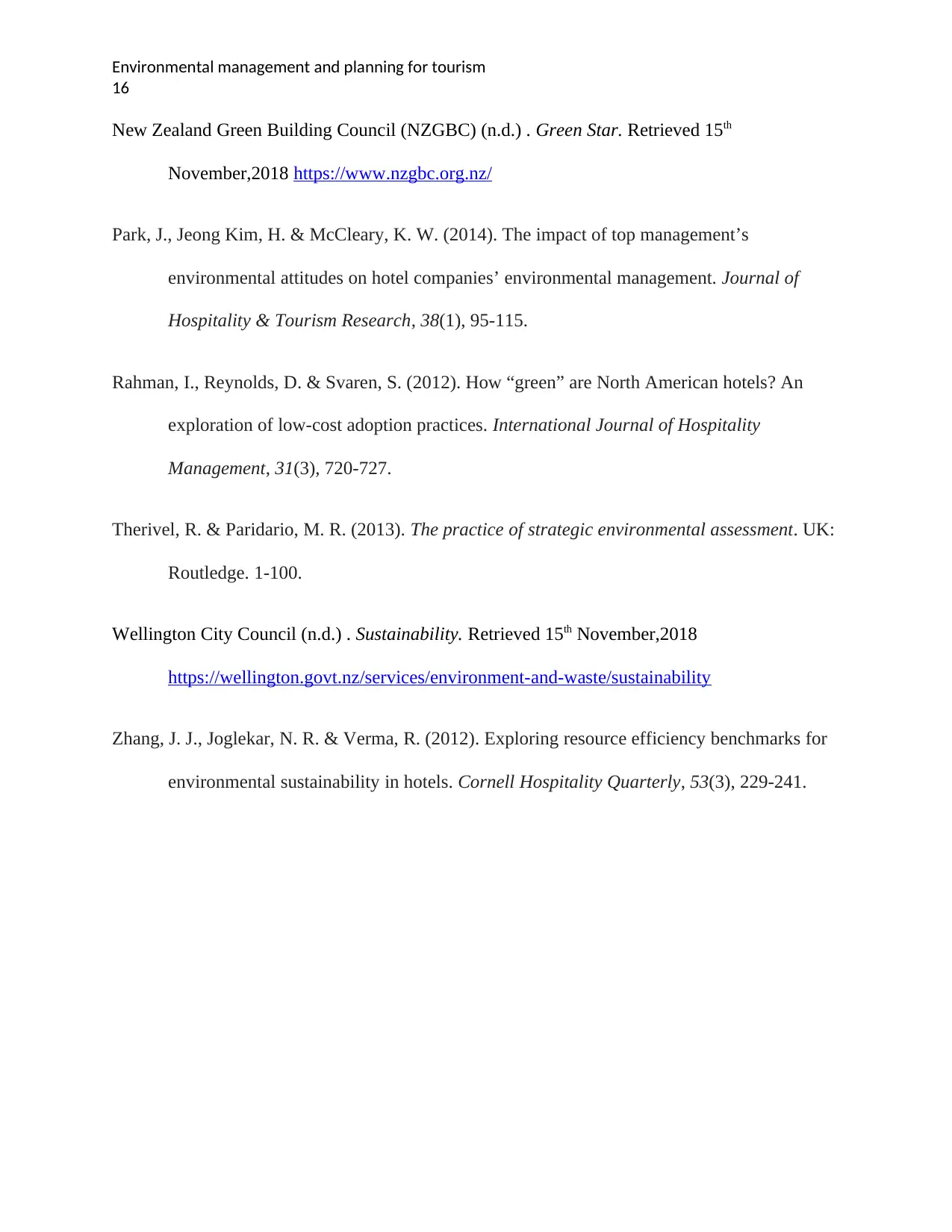
Environmental management and planning for tourism
16
New Zealand Green Building Council (NZGBC) (n.d.) . Green Star. Retrieved 15th
November,2018 https://www.nzgbc.org.nz/
Park, J., Jeong Kim, H. & McCleary, K. W. (2014). The impact of top management’s
environmental attitudes on hotel companies’ environmental management. Journal of
Hospitality & Tourism Research, 38(1), 95-115.
Rahman, I., Reynolds, D. & Svaren, S. (2012). How “green” are North American hotels? An
exploration of low-cost adoption practices. International Journal of Hospitality
Management, 31(3), 720-727.
Therivel, R. & Paridario, M. R. (2013). The practice of strategic environmental assessment. UK:
Routledge. 1-100.
Wellington City Council (n.d.) . Sustainability. Retrieved 15th November,2018
https://wellington.govt.nz/services/environment-and-waste/sustainability
Zhang, J. J., Joglekar, N. R. & Verma, R. (2012). Exploring resource efficiency benchmarks for
environmental sustainability in hotels. Cornell Hospitality Quarterly, 53(3), 229-241.
16
New Zealand Green Building Council (NZGBC) (n.d.) . Green Star. Retrieved 15th
November,2018 https://www.nzgbc.org.nz/
Park, J., Jeong Kim, H. & McCleary, K. W. (2014). The impact of top management’s
environmental attitudes on hotel companies’ environmental management. Journal of
Hospitality & Tourism Research, 38(1), 95-115.
Rahman, I., Reynolds, D. & Svaren, S. (2012). How “green” are North American hotels? An
exploration of low-cost adoption practices. International Journal of Hospitality
Management, 31(3), 720-727.
Therivel, R. & Paridario, M. R. (2013). The practice of strategic environmental assessment. UK:
Routledge. 1-100.
Wellington City Council (n.d.) . Sustainability. Retrieved 15th November,2018
https://wellington.govt.nz/services/environment-and-waste/sustainability
Zhang, J. J., Joglekar, N. R. & Verma, R. (2012). Exploring resource efficiency benchmarks for
environmental sustainability in hotels. Cornell Hospitality Quarterly, 53(3), 229-241.
1 out of 17
Related Documents
Your All-in-One AI-Powered Toolkit for Academic Success.
+13062052269
info@desklib.com
Available 24*7 on WhatsApp / Email
![[object Object]](/_next/static/media/star-bottom.7253800d.svg)
Unlock your academic potential
© 2024 | Zucol Services PVT LTD | All rights reserved.



